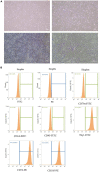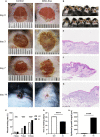Exosomes Derived From Umbilical Cord Mesenchymal Stem Cells Treat Cutaneous Nerve Damage and Promote Wound Healing
- PMID: 35846563
- PMCID: PMC9279568
- DOI: 10.3389/fncel.2022.913009
Exosomes Derived From Umbilical Cord Mesenchymal Stem Cells Treat Cutaneous Nerve Damage and Promote Wound Healing
Abstract
Wound repair is a key step in the treatment of skin injury caused by burn, surgery, and trauma. Various stem cells have been proven to promote wound healing and skin regeneration as candidate seed cells. Therefore, exosomes derived from stem cells are emerging as a promising method for wound repair. However, the mechanism by which exosomes promote wound repair is still unclear. In this study, we reported that exosomes derived from umbilical cord mesenchymal stem cells (UC-MSCs) promote wound healing and skin regeneration by treating cutaneous nerve damage. The results revealed that UC-MSCs exosomes (UC-MSC-Exo) promote the growth and migration of dermal fibroblast cells. In in vitro culture, dermal fibroblasts could promote to nerve cells and secrete nerve growth factors when stimulated by exosomes. During the repair process UC-MSC-Exo accelerated the recruitment of fibroblasts at the site of trauma and significantly enhanced cutaneous nerve regeneration in vivo. Interestingly, it was found that UC-MSC-Exo could promote wound healing and skin regeneration by recruiting fibroblasts, stimulating them to secrete nerve growth factors (NGFs) and promoting skin nerve regeneration. Therefore, we concluded that UC-MSC-Exo promote cutaneous nerve repair, which may play an important role in wound repair and skin regeneration.
Keywords: cutaneous nerve regeneration; exosome; nerve growth factor; regeneration; umbilical cord mesenchymal stem cells; wound repair.
Copyright © 2022 Zhu, Zhang, Hao, Xu, Shu, Hou and Wang.
Conflict of interest statement
The authors declare that the research was conducted in the absence of any commercial or financial relationships that could be construed as a potential conflict of interest.
Figures







Similar articles
-
MSC Exosomes Containing Valproic Acid Promote Wound Healing by Modulating Inflammation and Angiogenesis.Molecules. 2024 Sep 9;29(17):4281. doi: 10.3390/molecules29174281. Molecules. 2024. PMID: 39275128 Free PMC article.
-
Exosomes derived from human umbilical cord blood mesenchymal stem cells stimulate regenerative wound healing via transforming growth factor-β receptor inhibition.Stem Cell Res Ther. 2021 Aug 3;12(1):434. doi: 10.1186/s13287-021-02517-0. Stem Cell Res Ther. 2021. PMID: 34344478 Free PMC article.
-
Umbilical Cord-Derived Mesenchymal Stem Cell-Derived Exosomes Combined Pluronic F127 Hydrogel Promote Chronic Diabetic Wound Healing and Complete Skin Regeneration.Int J Nanomedicine. 2020 Aug 11;15:5911-5926. doi: 10.2147/IJN.S249129. eCollection 2020. Int J Nanomedicine. 2020. PMID: 32848396 Free PMC article.
-
Exosomal microRNAs from Mesenchymal Stem Cells: Novel Therapeutic Effect in Wound Healing.Tissue Eng Regen Med. 2023 Aug;20(5):647-660. doi: 10.1007/s13770-023-00542-z. Epub 2023 May 2. Tissue Eng Regen Med. 2023. PMID: 37131016 Free PMC article. Review.
-
Mesenchymal stem cell-derived exosomes: A novel and potential remedy for cutaneous wound healing and regeneration.World J Stem Cells. 2022 May 26;14(5):318-329. doi: 10.4252/wjsc.v14.i5.318. World J Stem Cells. 2022. PMID: 35722196 Free PMC article. Review.
Cited by
-
Roles of extracellular vesicles from mesenchymal stem cells in regeneration.Mol Cells. 2024 Dec;47(12):100151. doi: 10.1016/j.mocell.2024.100151. Epub 2024 Nov 13. Mol Cells. 2024. PMID: 39547584 Free PMC article. Review.
-
Global Trends of Exosomes Application in Clinical Trials: A Scoping Review.Stem Cell Rev Rep. 2024 Nov;20(8):2165-2193. doi: 10.1007/s12015-024-10791-7. Epub 2024 Sep 28. Stem Cell Rev Rep. 2024. PMID: 39340738
-
Exosomes: A Promising Cell-Free Therapeutic Tool for Treating Cutaneous Nerve Injuries and Promoting Wound Healing.Int J Mol Sci. 2025 Jun 1;26(11):5323. doi: 10.3390/ijms26115323. Int J Mol Sci. 2025. PMID: 40508132 Free PMC article. Review.
-
Research Progress on the Osteogenesis-Related Regulatory Mechanisms of Human Umbilical Cord Mesenchymal Stem Cells.Stem Cell Rev Rep. 2023 Jul;19(5):1252-1267. doi: 10.1007/s12015-023-10521-5. Epub 2023 Mar 14. Stem Cell Rev Rep. 2023. PMID: 36917312 Review.
-
The capacity of exosomes derived from adipose-derived stem cells to enhance wound healing in diabetes.Front Pharmacol. 2023 Sep 21;14:1063458. doi: 10.3389/fphar.2023.1063458. eCollection 2023. Front Pharmacol. 2023. PMID: 37808198 Free PMC article. Review.
References
LinkOut - more resources
Full Text Sources

